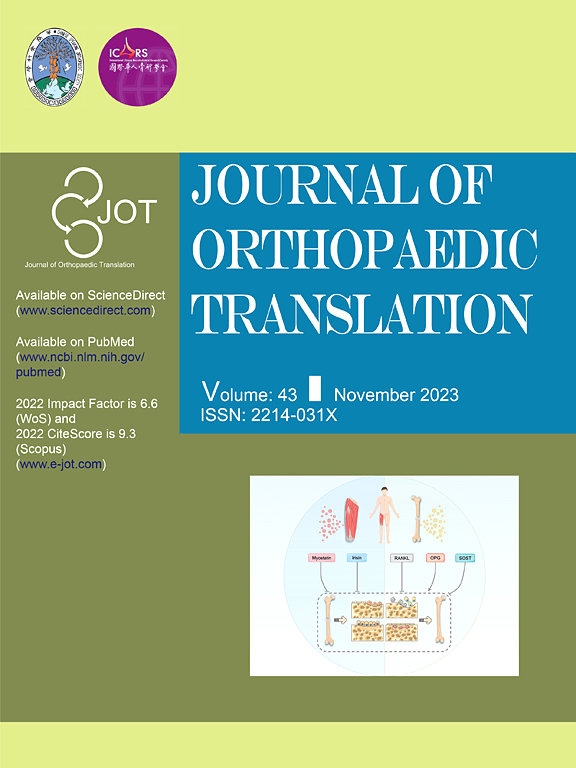Establishment of a clinically relevant beagle model for periprosthetic joint infection with 3D-printed prostheses and multimodal evaluation
IF 5.9
1区 医学
Q1 ORTHOPEDICS
引用次数: 0
Abstract
Objective
Periprosthetic joint infection (PJI) poses significant challenges to arthroplasty outcomes, necessitating translational animal models for pathogenesis studies and therapeutic development. This study aimed to establish a standardized Beagle PJI model by integrating species-specific 3D-printed femoral prostheses with quantitative bacterial inoculation, while evaluating the dose-dependent effects of Staphylococcus aureus (S. aureus) on infection progression.
Methods
Two titanium alloy prostheses were designed using CT-based anatomical data: BFP-C (canine-optimized) and BFP-H (human-derived). Prostheses underwent mechanical compression tests, finite element analysis (FEA) simulating postoperative and osseointegration phases, and in vivo validation in Beagles. The optimized BFP-C was selected for PJI model construction via hemi-hip arthroplasty (HHA), with intraoperative inoculation of S. aureus ranging from 250 to 10^8 colony-forming units (CFU). Longitudinal evaluation included radiography (X-ray/CT), mechanical pull-out tests, histopathology (H&E/Masson/Giemsa staining), bacterial cultures, and mobility assessments using open-field behavioural tracking.
Results
BFP-C exhibited superior biomechanical compatibility, with 12.3-fold higher yield strength (6836 ± 157 N vs. 553 ± 49 N) and 97 % reduction in bone strain (0.71 % vs. 20.32 %) compared to BFP-H. All inoculated groups developed PJI with dose-dependent severity: ultra-high-dose (10^8 CFU) groups displayed severe osteolysis (pull-out strength: 24 ± 8 N vs. 924 ± 45 N in controls), biofilm formation, and mobility impairment (74 % reduction in distance travelled, 2003 ± 276 cm vs. 7976 ± 333 cm in controls), whereas low-dose (250 CFU) groups established PJI with milder manifestations, evidenced by sinus tract formation, 55.1 % reduction in pull-out strength (406 ± 15 N vs. 924 ± 45 N in controls), and concordant radiological/histopathological signs of infection. Imaging examinations revealed differential osteolytic patterns corresponding to bacterial loads. Combined wound evaluation and microbiological analyses confirmed consistent infection establishment across all replicates.
Conclusion
This Beagle PJI model successfully recapitulates clinical infection dynamics, emphasizing the critical role of species-specific prosthesis design and standardized bacterial quantification. The integrated multimodal evaluation system (imaging, biomechanical, and behavioural analyses) demonstrated both the reliability of the model and its sensitivity in detecting infection progression. Its modular design supports customization for studying biofilm-resistant implants or antibiotic delivery systems. These findings not only provide a critical tool for mechanistic PJI research but also establish a theoretical foundation for clinical translation, with the quantitative multimodal framework directly informing diagnostic and therapeutic strategies.
Translational potential
Beyond serving as a preclinical platform for anti-infective therapies, the model provides actionable insights into optimizing human prosthetic biomechanics, such as reducing stress shielding through FEA-informed design principles. The 3D printing workflow further demonstrates rapid prototyping capabilities for patient-specific orthopaedic implants.

应用3d打印假体建立具有临床意义的假体周围关节感染beagle模型及多模态评估
目的假体周围关节感染(PJI)对关节置换术的疗效构成重大挑战,需要建立可转化的动物模型来研究其发病机制和治疗方法。本研究旨在通过将物种特异性3d打印股骨假体与定量细菌接种相结合,建立标准化的Beagle PJI模型,同时评估金黄色葡萄球菌(S. aureus)对感染进展的剂量依赖性作用。方法利用ct解剖数据设计两种钛合金假体:BFP-C(犬型)和BFP-H(人型)。假体进行了机械压缩测试,模拟术后和骨整合阶段的有限元分析(FEA),并在比格犬体内验证。选择优化后的BFP-C通过半髋关节置换术(HHA)构建PJI模型,术中接种金黄色葡萄球菌250 ~ 10^8菌落形成单位(CFU)。纵向评估包括x线摄影(x射线/CT)、机械拔牙试验、组织病理学(H&;E/Masson/Giemsa染色)、细菌培养和开放性行为追踪的活动性评估。结果与bmp - h相比,bmp - c的屈服强度(6836±157 N比553±49 N)提高了12.3倍,骨应变降低了97%(0.71%比20.32%),具有较好的生物力学相容性。所有接种组均出现严重程度依赖于剂量的PJI:超高剂量(10^8 CFU)组出现严重的骨溶解(拔出强度:24±8 N,对照组924±45 N),生物膜形成和活动障碍(行走距离减少74%,2003±276 cm,对照组7976±333 cm),而低剂量(250 CFU)组建立的PJI表现较轻,表现为窦道形成,拔出力减少55.1%(406±15 N,对照组924±45 N),并有一致的放射学/组织病理学感染迹象。影像学检查显示不同的溶骨模式对应于细菌负荷。综合伤口评估和微生物分析证实了所有重复中一致的感染建立。结论该Beagle PJI模型成功再现了临床感染动力学,强调了物种特异性假体设计和标准化细菌定量的关键作用。综合多模式评估系统(成像、生物力学和行为分析)证明了该模型的可靠性及其在检测感染进展方面的敏感性。其模块化设计支持定制研究生物膜抗性植入物或抗生素输送系统。这些发现不仅为PJI机制研究提供了重要工具,而且为临床翻译奠定了理论基础,定量的多模态框架直接指导诊断和治疗策略。除了作为抗感染治疗的临床前平台外,该模型还为优化人体假体生物力学提供了可行的见解,例如通过基于有限元分析的设计原则减少应力屏蔽。3D打印工作流程进一步展示了针对特定患者的骨科植入物的快速原型制作能力。
本文章由计算机程序翻译,如有差异,请以英文原文为准。
求助全文
约1分钟内获得全文
求助全文
来源期刊

Journal of Orthopaedic Translation
Medicine-Orthopedics and Sports Medicine
CiteScore
11.80
自引率
13.60%
发文量
91
审稿时长
29 days
期刊介绍:
The Journal of Orthopaedic Translation (JOT) is the official peer-reviewed, open access journal of the Chinese Speaking Orthopaedic Society (CSOS) and the International Chinese Musculoskeletal Research Society (ICMRS). It is published quarterly, in January, April, July and October, by Elsevier.
 求助内容:
求助内容: 应助结果提醒方式:
应助结果提醒方式:


